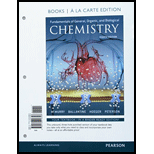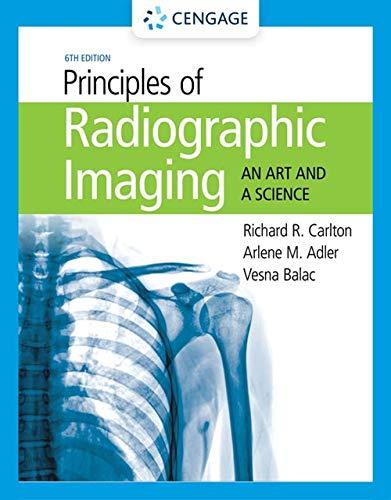
Fundamentals of General, Organic, and Biological Chemistry, Books a la Carte Edition; Modified Mastering Chemistry with Pearson eText -- ValuePack ... and Biological Chemistry (4th Edition)
4th Edition
ISBN: 9780134465715
Author: John E. McMurry, David S. Ballantine
Publisher: PEARSON
expand_more
expand_more
format_list_bulleted
Textbook Question
Chapter 2.1, Problem 2.2CIAP
For the Kanji character in the lower portion of figure (a):
(1) How wide is the character in terms of iron atoms?
(2) Given the radius of an iron atom is 126 pm, calculate the width of this character in centimeters.
Expert Solution & Answer
Want to see the full answer?
Check out a sample textbook solution
Students have asked these similar questions
walk me through how you would answer this please
please help and show arrow pushing.
please work through it and explain how you got the answers
roblem Two – part aFirst separation step.....What type of column was used? __________________________ pH used: ________Protein(s) in early fraction? ____________ protein(s) in late fraction? _______Second separation step....Proteins applied to the second column? ___________What type of column was used? __________________________ pH used: ________Protein(s) in early fraction? ____________ protein(s) in late fraction? _______
Chapter 2 Solutions
Fundamentals of General, Organic, and Biological Chemistry, Books a la Carte Edition; Modified Mastering Chemistry with Pearson eText -- ValuePack ... and Biological Chemistry (4th Edition)
Ch. 2.1 - Prob. 2.1CIAPCh. 2.1 - For the Kanji character in the lower portion of...Ch. 2.2 - Use the list inside the front cover to identify...Ch. 2.3 - Prob. 2.2PCh. 2.3 - Prob. 2.3PCh. 2.3 - Prob. 2.4PCh. 2.4 - Prob. 2.5PCh. 2.4 - Prob. 2.6PCh. 2.4 - Prob. 2.7PCh. 2.4 - Prob. 2.8P
Ch. 2.4 - Prob. 2.9PCh. 2.5 - Prob. 2.10PCh. 2.5 - Prob. 2.11PCh. 2.5 - Prob. 2.12PCh. 2.5 - Prob. 2.13KCPCh. 2.5 - Prob. 2.3CIAPCh. 2.5 - Prob. 2.4CIAPCh. 2.6 - Prob. 2.14PCh. 2.7 - Prob. 2.15PCh. 2.7 - Write electron configurations for the following...Ch. 2.7 - Prob. 2.17PCh. 2.7 - Identify the atom with the following...Ch. 2.8 - Prob. 2.19PCh. 2.8 - Prob. 2.20PCh. 2.8 - Prob. 2.21PCh. 2.8 - Prob. 2.22KCPCh. 2.9 - Prob. 2.23PCh. 2.9 - Write electron-dot symbols for radon, lead, xenon,...Ch. 2.9 - Prob. 2.25PCh. 2.9 - Prob. 2.5CIAPCh. 2.9 - Prob. 2.6CIAPCh. 2 - Where on the following outline of a periodic table...Ch. 2 - Is the element marked in red on the following...Ch. 2 - Prob. 2.28UKCCh. 2 - What atom has the following orbital-filling...Ch. 2 - Use the following orbital-filling diagram to show...Ch. 2 - What four fundamental assumptions about atoms and...Ch. 2 - How do atoms of different elements differ?Ch. 2 - Prob. 2.33APCh. 2 - Prob. 2.34APCh. 2 - Prob. 2.35APCh. 2 - Prob. 2.36APCh. 2 - How many O atoms of mass 15.99 amu are in 15.99 g...Ch. 2 - Prob. 2.38APCh. 2 - What are the names of the three subatomic...Ch. 2 - Prob. 2.40APCh. 2 - Prob. 2.41APCh. 2 - Prob. 2.42APCh. 2 - Which of the following symbols represent isotopes...Ch. 2 - Prob. 2.44APCh. 2 - Prob. 2.45APCh. 2 - Prob. 2.46APCh. 2 - One of the most widely used isotopes in medical...Ch. 2 - Prob. 2.48APCh. 2 - Prob. 2.49APCh. 2 - Prob. 2.50APCh. 2 - Prob. 2.51APCh. 2 - Prob. 2.52APCh. 2 - Prob. 2.53APCh. 2 - Prob. 2.54APCh. 2 - Prob. 2.55APCh. 2 - For (a) rubidium (b) tungsten, (c) germanium, and...Ch. 2 - For (a) calcium, (b) palladium, (c) carbon, and...Ch. 2 - Prob. 2.58APCh. 2 - Prob. 2.59APCh. 2 - Prob. 2.60APCh. 2 - Prob. 2.61APCh. 2 - Prob. 2.62APCh. 2 - Prob. 2.63APCh. 2 - Prob. 2.64APCh. 2 - Prob. 2.65APCh. 2 - Prob. 2.66APCh. 2 - Prob. 2.67APCh. 2 - Prob. 2.68APCh. 2 - Prob. 2.69APCh. 2 - Prob. 2.70APCh. 2 - Prob. 2.71APCh. 2 - Determine the number of unpaired electrons for...Ch. 2 - Without looking back in the text, write the...Ch. 2 - Prob. 2.74APCh. 2 - Prob. 2.75APCh. 2 - Prob. 2.76APCh. 2 - Prob. 2.77APCh. 2 - Prob. 2.78APCh. 2 - Using n for the number of the valence shell and...Ch. 2 - What elements in addition to helium make up the...Ch. 2 - Prob. 2.81CPCh. 2 - What is the atomic number of the yet-undiscovered...Ch. 2 - Give the number of electrons in each shell for...Ch. 2 - Identify the highest-energy occupied subshell in...Ch. 2 - Prob. 2.85CPCh. 2 - Prob. 2.86CPCh. 2 - Germanium, atomic number 32, is used in building...Ch. 2 - Prob. 2.88CPCh. 2 - Prob. 2.89CPCh. 2 - What is wrong with the following electron...Ch. 2 - Prob. 2.91CPCh. 2 - Prob. 2.92CPCh. 2 - Prob. 2.93CPCh. 2 - Prob. 2.94CPCh. 2 - Prob. 2.95GPCh. 2 - Prob. 2.96GPCh. 2 - Prob. 2.97GPCh. 2 - Look again at the trends illustrated in Figures...
Knowledge Booster
Learn more about
Need a deep-dive on the concept behind this application? Look no further. Learn more about this topic, biochemistry and related others by exploring similar questions and additional content below.Similar questions
- please help and explair you'd count the disulfide bonds caused by the cystines and include the n and c terminusarrow_forwardc. C₂H₂ 'alkyne d. C7H12 alkyne 2. Draw the line-angle formula for the following compounds. a. 4,4-diethyloctane 2 3 7 8 b. 4-ethyl-2,2-dimethylhexanearrow_forwardHenderson Hasselbalch Practice Sheet. 1) Buffered solution 1 has a pH of 8. [A-] = 100 mM, [HA] = 10 mM. Solve for pKa of this acid. 2) A phosphate buffer (pk2 = 7.2) has molar concentrations of [H2PO4 ] = 100 µM, [HPO42-] = 1 mM. Solve for pH. = 3) When pH 5, the pKa of the acid = 7, and the molar concentration of acid = 100 μM, what is the molar concentration of the base? 3arrow_forward
- 7. Which one is the major organic product obtained from the following reaction? CHO COOH CH₂OH CHO COOH H- -OH H₂ H- OH H- -OH H- -OH Ni HO -H HO -H HO- -H HO- H HO- H H- -OH H- -OH H- -OH H -OH H- -OH H- -OH H- -OH H- -OH H- -OH H -OH CH₂OH CH₂OH CH₂OH CH₂OH COOH A B C Darrow_forward4. The compound on the right is- B) a ketopentose C) an aldohexose A) an aldopentose D) a ketohexose E) a ketoheptose OH OH CH2OH OHarrow_forward12. When glutamic acid is heated to 180°C., it loses a molecule of water to form a lactam. The bond that creates the lactam is an amide bond that forms between the amino nitrogen and the carbon of the side chain -COOH group. What is the most reasonable structure for this lactam? (NOTE: The structure of glutamic acid is shown in Question 1.) COOH COOH ا کچھ جو کچھ C D COOH B COOH E COOHarrow_forward
- 10. Which one of the following compounds is the major organic product of the series of reactions shown here? Ph A OH Ph B CO₂Et Br -H Ν ΚΑ CO₂Et 1. NaOEt 1. NaOH, H₂O 2. H3O+ 2. PhCH2CH2Br 3. heat NH2 Ph OH NH2 0 OH Ph OH NH2 Ph D NH2 E OHarrow_forward1. What is the isoelectric point of glutamic acid? (Glutamic acid has pKa1 2.10, pKa2 4.07, pKaз 9.47) A) pH 2.1 D) pH 6.8 B) pH 3.1 C) pH 4.1 E) pH 9.5 HO NH2 Glutamic acid (shown without charges) OHarrow_forwardBr Mg, ether 1. HCHO (formaldehyde) 2. H+, H₂O PCC 1. NH3, HCN ? (pyridinium chlorochromate) 2. H2O, HCI 11. Which one of the following compounds is the major organic product of the series of reactions shown above? Ph. Ph. OH NH2₂ A Ph. Ή NH2 B OH Ph Η Ph OH NH2 NH2₂ NH₂ C D Earrow_forward
- B A 6. Which ONE of the labeled bonds in the tripeptide on the right is a peptide bond: H₂N N 'N' OH C H A, B, C, D or E? HN E OHarrow_forwardQuestions 8-9 are 0.4 points each. The next two questions relate to the peptide whose structure is shown here. To answer these questions, you should look at a table of H2N/.. amino acid structures. You don't have to memorize the structures of the amino acids. IZ 8. What is the N-terminal amino acid of this peptide? A) proline B) aspartic acid C) threonine 9. What is the C-terminal amino acid of this peptide? A) proline B) aspartic acid C) threonine N OH D) valine E) leucine D) valine E) leucine NH "OH OHarrow_forward7. What is the correct name of the following tripeptide? A) Ile-Met-Ser B) Leu-Cys-Thr C) Val-Cys-Ser D) Ser-Cys-Leu E) Leu-Cys-Ser H₂N!!!!! N H ΖΙ .SH SF H IN OH OHarrow_forward
arrow_back_ios
SEE MORE QUESTIONS
arrow_forward_ios
Recommended textbooks for you
 Principles Of Radiographic Imaging: An Art And A ...Health & NutritionISBN:9781337711067Author:Richard R. Carlton, Arlene M. Adler, Vesna BalacPublisher:Cengage Learning
Principles Of Radiographic Imaging: An Art And A ...Health & NutritionISBN:9781337711067Author:Richard R. Carlton, Arlene M. Adler, Vesna BalacPublisher:Cengage Learning



Principles Of Radiographic Imaging: An Art And A ...
Health & Nutrition
ISBN:9781337711067
Author:Richard R. Carlton, Arlene M. Adler, Vesna Balac
Publisher:Cengage Learning



GCSE Chemistry - Acids and Bases #34; Author: Cognito;https://www.youtube.com/watch?v=vt8fB3MFzLk;License: Standard youtube license